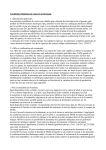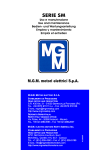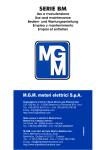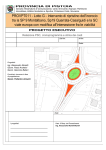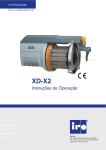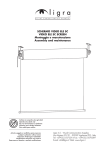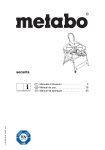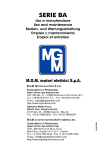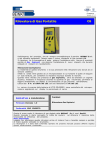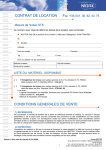Download SERIE BA - MGM Electric Motors
Transcript
STABILIMENTO E UFFICI: S.R. 435 KM. 31 - 51030 SERRAVALLE PISTOIESE (PT) TEL. 0573.91511 R.A. - FAX 0573.518138 E-MAIL: [email protected] http://www.mgmrestop.com M.G.M. motori elettrici S.p.A. SEDE LEGALE E DEPOSITO NORD-ITALIA: NORTH ITALY BRANCH OFFICE: VIA FERMI, 44 - 20090 ASSAGO - MILANO TEL. 02.48843593 - FAX 02.48842837 ISO 9001:2000 M.G.M. ELECTRIC MOTORS NORTH AMERICA INC. 9731, MÉTROPOLITAIN BLVD. EAST MONTRÉAL, QUÉBEC H1J 3C1 - CANADA TEL. +1 (514) 355-4343 - FAX +1 (514) 355-5199 Per qualsiasi difficoltà Vi preghiamo contattare l'organizzazione della MGM e prendere visione delle istruzioni d'uso e manutenzione nella versione più completa e aggiornata sul nostro sito web (www.mgmrestop.com) Si vous avez des difficultés, contactez l'organisation M.G.M. et consultez les instructions de mise en route et de maintenance détaillées et à jour sur notre site (www.mgmrestop.com) Por cualquier tipo de dificultad, les rogamos ponerse en contacto con la organizaciòn de M.G.M. y coger las instrucciones des uso y manutenciòn en las versiòn mas completa y actualizada en nuestra página web ( www.mgmrestop.com) Sollten Schwierigkeiten jeglicher Art auftreten,setzen Sie sich bitte mit dem M.G.M.-Stammhaus in Verbindung und sehen Sie die ausführlichen Betriebs-und Wartungsanleitungen auf unserer Web.Site ( www.mgmrestop.com) ein. I T A L I A N O SERIE BA Le attività di manutenzione devono essere svolte solo da personale qualificato e solo dopo aver scollegato l'impianto o il motore dalla rete di alimentazione elettrica. La carenza di ispezioni e manutenzione può causare gravi danni a persone o cose. Manutenzione Le attività di manutenzione devono essere eseguite da personale qualificato (IEC 60364) solo dopo aver preventivamente scollegato l'impianto o il motore dalla rete (compreso eventuali ausiliari e in particolare le scaldiglie anticondensa) e aver verificato che all'albero motore non risulti applicato A19H0102 Should any difficulty arise please contact MGM organization and download the 'Use and Maintenance' in its last and complete version directly from our web site( www.mgmrestop.com) nessun carico. Per motivi di sicurezza la vite di sblocco del freno e la chiave a "T" non devono essere mai lasciate inserite sul motore ma rimosse e custodite dal responsabile della manutenzione dell'impianto dopo ogni intervento. La chiave a “T“deve essere utilizzata soltanto quando il motore è scollegato dalla rete di alimentazione e solo dopo aver verificato che all’albero motore non risulti applicato nessun carico. Dopo ogni intervento sul gruppo freno verificare sempre la chiusura della cuffia (26) attraverso un adeguato serraggio della vite TE (27). Di seguito sono elencate le attività che devono essere svolte periodicamente per assicurare il corretto funzionamento del motore autofrenante MGM. La frequenza delle ispezioni dipende dalla particolare applicazione del motore (numero di avviamenti, momento di inerzia applicato, condizioni ambientali etc.). Si consiglia di effettuare le prime ispezioni a distanza di alcune settimane di funzionamento e di redigere conseguentemente un programma di manutenzione periodica. Si raccomanda comunque di programmare le ispezioni successive con frequenza non inferiore a 2 volte all'anno. Per eventuali informazioni contattare l'organizzazione della M.G.M. motori elettrici S.p.A. - Verificare periodicamente che il motore funzioni correttamente senza rumori o vibrazioni anomale e che le aperture per il passaggio dell'aria per la ventilazione non siano ostruite. - Verificare il corretto serraggio dei cavi di alimentazione del motore e del freno e del conduttore di terra. - Verificare che, per effetto dell'usura della guarnizione di attrito del disco freno, il traferro non sia al di fuori dei valori indicati nella tabella 1. Si consideri che l'usura è maggiore durante la fase di rodaggio. Per la regolazione del traferro seguire le indicazioni riportate nel paragrafo "Regolazione del Traferro". - Verificare lo stato di usura della superficie di attrito da entrambe le parti del disco freno (per i motori serie BAPV da una sola parte) assicurandosi che lo spessore non scenda al di sotto di 2 mm. Verificare inoltre l'assenza di danneggiamenti sulla superficie del disco ed in particolare nella dentatura del mozzo. (Per l'eventuale sostituzione consultare il paragrafo "Sostituzione del Disco Freno"). Per i dischi con pista di attrito rivettata verificare che la superficie frenante non abbia raggiunto il livello dei rivetti; verificare inoltre che non ci sia gioco tra il mozzo e il disco in corrispondenza dei chiodi. - Verificare periodicamente che la coppia frenante sia adeguata. Se necessario procedere alla regolazione secondo quanto indicato nel paragrafo 'Regolazione coppia frenante '. - Verificare periodicamente lo stato di usura delle colonnette di guida (19-42) e il loro saldo ancoraggio sul convogliatore (17). - Tutti i componenti del gruppo freno e in particolare il disco freno (23, 39-41 per BAF, 45 per BAPV) e le colonnette di guida (19, 42 per BAF-BAPV) sono componenti soggetti ad usura. In considerazione della funzione di sicurezza svolta è necessario effettuare, come manutenzione preventiva, la sostituzione periodica. La frequenza dipende dal tipo di lavoro svolto dal motore (numero di avviamenti, momento di inerzia applicato, condizioni ambientali etc.); si raccomanda comunque di provvedere alla sostituzione con una frequenza non superiore ai 18 mesi. - Verificare periodicamente lo stato di usura della dentatura dell'albero dove scorre il disco freno. Regolazione Coppia Frenante La coppia frenante è proporzionale alla compressione delle molle (18) che può essere variata agendo sui dadi (20). Nella tabella 2 e 3 sono riportati i valori di compressione standard (H std) delle molle. La coppia frenante corrispondente alla regolazione standard della compressione delle molle riportata in tabella è solitamente inferiore a quella massimo riportata sulla targa del motore, soprattutto per i gruppi freno con elettromagnete AC. Dopo aver effettuato la registrazione verificare sempre che la coppia frenante sia idonea per l'utilizzo previsto. Se alimentando il freno l'elettromagnete non riuscisse a richiamare l'ancora mobile (24) con un colpo secco e a tenerla attratta senza vibrazioni, verificare l'esatta regolazione del traferro (60) e, se l'inconveniente persiste, allentare i dadi (20) e riprovare sino ad ottenere il funzionamento corretto.Per motori che possono essere provvisti di 3 oppure 6 molle (serie BA 160÷225) porre attenzione alla diversa regolazione della compressione delle molle necessaria per il raggiungimento della coppia frenante desiderata. Verificare sempre a fine intervento che la coppia frenante registrata sia adeguata. Non superare mai il valore di coppia frenante massimo riportato in targa. Si consiglia di evitare di regolare la coppia frenante a valori inferiori al 30% del valore massimo.. Elettromagnete AC Tipo H std (mm) Tabella 2 3 71 80 90 100 112 132 12,5 12,0 15,5 15,0 15,5 17,0 160 1 20,5 180 1 35,5 1 2251 35,5 34,0 200 Elettromagnete DC Tipo H std (mm) Tabella 3 3 71 80 90 100 112 132 13,2 12,5 16,0 15,0 16,0 17,0 160 2 18,0 180 2 32,0 2 2252 32,0 32,0 200 1) i gruppi freno dei motori serie BA, BAF 160÷225 con elettromagnete AC hanno 6 molle; 2) i gruppi freno dei motori della serie BA 160÷225 con elettromagnete DC hanno 3 molle. Le molle devono essere disposte su 3 colonnette poste a 120° per garantire un'azione frenante uniforme.Le altre 3 colonnette sono senza molle. 3) i gruppi freno dei motori serie BA, BAPV, BAF 132 con elettromagnete AC hanno le molle di colore giallo. I gruppi freno dei motori serie BA, BAPV 132 con elettromagnete DC hanno le molle di colore nero. Sostituzione del Disco Freno Svitare la vite T.E. (27), togliere la cuffia (26) e svitare i dadi (22), sfilare l'elettromagnete (25) dalle colonnette (19), togliere i dadi (20-21) e le molle (18). Estrarre l'ancora mobile (24) dalle colonnette (19), togliere il disco freno (23) vecchio ed inserire il disco nuovo. Procedere a ritroso per il successivo montaggio. Si raccomanda di maneggiare il disco freno con le mani pulite perché ogni traccia di grasso diminuisce la capacità frenante e aumenta la rumorosità. Nei motori BAF rispetto alla versione BA ci sono due dischi freno (39-41), con interposta la pista di attrito ausiliaria (40). Dopo aver montato l'elettromagnete (25) procedere alla regolazione del traferro. Per i motori della serie BAPV per la sostituzione dei dischi volano (45) attenersi alle istruzioni specifiche. Sostituzione dell’Elettromagnete Svitare la vite T.E. (27), togliere la cuffia (26), scollegare i connettori dell'elettromagnete (25), svitare i dadi (22) e sfilare dalle colonnette (19) l'elettromagnete (25). Ricollocare sulle colonnette il nuovo elettromagnete e i dadi ed effettuare il collegamento elettrico avendo cura di disporre i connettori nella posizione che rende possibile l'innesto. Prima di rimontare la cuffia di protezione freno (26) verificare che i connettori e i relativi cavi siano ben ancorati. Procedere con la regolazione del traferro (vedere relativo paragrafo). Verificare che l'elettromagnete funzioni regolarmente; alimentando il freno l'elettromagnete (25) deve richiamare l'ancora mobile (24) con un colpo secco e tenerla attratta senza alcuna vibrazione o rumorosità. Se l'ancora mobile (24) tendesse a vibrare occorre verificare che i terminali siano accoppiati correttamente. Regolazione del Traferro Il traferro (60), ossia la distanza tra i due nuclei elettromagnetici dell'elettromagnete (25) e dell'ancora mobile (24), deve rimanere entro i valori indicati nella tabella 1. E' necessario non oltrepassare tali valori, per evitare vibrazioni dell'ancora mobile, rumorosità eccessiva, l'eventuale bruciatura delle bobine dell'elettromagnete o il danneggiamento del gruppo freno. Il traferro tende ad aumentare per effetto dell‘usura del disco freno. Si consideri che l'usura del disco freno è maggiore durante la fase di rodaggio (alcune migliaia di frenate). Per riportare il traferro al valore richiesto occorre agire sulle coppie di dadi (21-22) che fermano l'elettromagnete (25) facendolo avanzare verso l'ancora mobile (24). Non è corretto serrare i dadi (22) di blocco dell'elettromagnete su una delle colonnette prima di aver ultimato la regolazione della posizione dell'elettromagnete su tutte le colonnette. Non si deve pertanto modificare la posizione dell'elettromagnete agendo su un dado interno (21), per fare una regolazione in corrispondenza di una colonnetta, se non sono stati allentati precedentemente i dadi esterni (22) su tutte le colonnette. Il traferro deve essere uniforme allo scopo di garantire il corretto funzionamento ed evitare sollecitazioni meccaniche dovute al cattivo allineamento. Per gruppi freno con 6 colonnette (19-42) effettuare inizialmente la regolazione della posizione dell'elettromagnete (agendo sui dadi 21-22) solo su 3 colonnette poste a 120°. Dopo aver registrato il traferro sulle prime 3 colonnette completare l'operazione sulle rimanenti 3 colonnette accostando prima i 3 dadi (21) a contatto con l'elettromagnete e serrando quindi i 3 dadi (22). Ad operazione conclusa verificare l'uniformità del traferro e il serraggio dei dadi (21-22). Tipo motore Traferro (mm) 71-80 0,25÷0,5 90-100 112-132 160-200 0,3÷0,6 0,4÷0,8 0,5÷1,0 225 0,6÷1,2 ATTENZIONE Il traferro deve rimanere entro i valori indicati in tabella per evitare possibili danneggiamenti del gruppo freno. Tabella 1 E N G L I S H BA SERIES Maintenance operations must be carried out only by qualified personnel and only after having disconnected the plant or the motors from the electrical supply. Inadequate inspections and maintenance can produce personal injury or property damage. Maintenance Maintenance operations must be carried out by qualified personnel (IEC 60364), and only after having disconnected the plant or the motor from the electrical supply (including any possible auxiliaries and especially anti-condensation heaters) and after having checked that no load is applied to the driveshaft. For security reasons the hand release (49) and the hexagonal "T" key (51) never must be fitted on the motor but removed and kept by the plant maintenance responsible after every intervention. The hexagonal “T” key must be used only after having disconnected the motor from the electrical supply and after having checked that no load is applied to the drive shaft. After any operation on brake assembly, verify that the end protection cover (26) is firmly held in place by the hexagonal rear nut (27). The operations which must be carried out periodically in order to ensure the correct functioning of the MGM brake motor are listed further on. The frequency of inspection depends on the particular motor duty ( number of start/stop, applied moment of inertia, environment conditions and so on). Generally it's advisable to proceed to the first inspection after few weeks of working and to draw up a periodical maintenance plan. Anyway it's recommended to provide inspections at least twice a year. For specific information pls contact the M.G.M. motori elettrici S.p.A. organization. - Periodically check that the motor operates correctly without noise or strange vibrations and that the openings for ventilation are not obstructed. - Verify that all motor and brake supply terminals are property tightened to the terminal board as well as the earthing terminal to the motor frame. - As a result of normal wear of the brake disc lining, check that the air gap does not exceed the values shown on table 1. Please note that the brake linings wear is greater during the run-in. ( few thousands stops). For the air gap adjustment, follow the instructions given into the paragraph "Air Gap Adjustment". - Check the wear on both friction surfaces of the brake disc (on one side only for BAPV series) to be sure that their thickness is not less than 2 mm. Verify also that there are no damages on disc surfaces and, in particular, in the hub toothing. (For replacement, refer to the paragraph "Brake Disc Replacement"). For those brake disc with rivets on disc lining verify that braking surface has not reached the rivets; moreover check that no play should be between the brake disc and the brake disc hub in correspondence of the hub nails. - Verify periodically that the braking torque is suitable. If needed, proceed to its adjustment as stated in the paragraph "Braking torque adjustment". - Verify regularly the brake adjuster (19-42) wear conditions and their steady fastening on the rear cover brake surface (17). - All brake assembly components, in particular the brake disc (23, 39-41 for BAF series, 45 for BAPV) and the brake adjusters (19, 42 for BAF-BAPV series) are subject to wear. In consideration of safety it's needed to replace them periodically. The replacement frequency comes from the motor duty (number of start/stop, applied moment of inertia, environment conditions and so on), we recommend however to replace them at least every 18 months. - Periodically check and verify the shaft splines wear, exactly where the disc slides. Braking Torque Adjustment The brake torque is proportional to the spring (18) compression. The compression of the springs must be as uniform as possible. On the table 2 and 3 are shown the standard compression values (H std) of the brake springs. The corresponding brake torque of the standard compression values stated on the table are less than the maximum braking torque stated on the motor nameplate, especially for AC brake assembly. Please verify that the braking torque is suitable for your application. If the brake coil (25) isn't able to call the brake moving element (24) back with a quick stroke and keep it attracted without vibrations, verify the exact air gap adjustment and, if this inconvenience still persists, loosen the locknut (20) and try it again until desired functioning is obtained.Some types of motors ( BA series 160÷225) can have 3 or 6 springs(18). Pay attention to the different adjustment of the spring compression to reach the brake torque value required. After every intervention pls verify that the braking torque is that required. Never exceed the maximum braking torque value stated on the motor name plate. It's recommended to avoid adjusting the braking torque to values lower than 30% of the maximum value. AC brake coil Type H std (mm) 71 80 90 12,5 12,0 15,5 100 112 1323 1601 1801 2001 15,0 15,5 17,0 20,5 35,5 35,5 H std (mm) 34,0 Table 2 DC brake coil Type 2251 71 80 90 100 112 1323 1602 1802 2002 2252 13,2 12,5 16,0 15,0 16,0 17,0 18,0 32,0 32,0 32,0 Table 3 1) The brake assembly of motor series BA, BAF 160÷225 with AC brake has 6 springs. 2) The brake assembly of motor series BA 160÷225 with DC brake has 3 springs. The 3 springs must be put on 3 brake adjusters situated at 120° to assure an uniform braking action. 3) The brake assembly of motor series BA, BAPV, BAF 132 with AC brake coil have the springs yellow coloured. The brake assembly of motor series BA, BAPV 132 with DC brake coil have the springs black coloured. Brake Disc Replacement Loosen the rear nut (27), remove the end cover (26) and unscrew the locknuts (22). Take off the brake coil (25) from the brake adjusters (19), remove the nuts (20-21) and the springs (18). Remove the brake moving element (24) sliding it through the brake adjusters (19). Take off the old brake disc (23) and put in the new one. For re-assembling, proceed backwards. We recommend that the new brake disc must be handled with clean hands, because even a small trace of grease will decrease the braking performance and also increase noise. In the BAF series otherwise than in the BA series there are 2 brake discs (39-41) with an intermediate brake moving element (40) in between. After the brake coil (25) replacement, proceed to the airgap adjustment (see the pertinent paragraph). For the flywheel (45) replacement on the BAPV series, follow up the specific instructions. Brake Coil Replacement Loosen the rear nut (27), remove the end cover (26), disconnect the brake coil (25). Unscrew the locknuts (22) and pull off the brake coil (25) from brake adjusters (19). Reassemble the new brake coil on the brake adjusters (19) and reconnect the electrical connectors. Pay attention to place the electrical connectors in the right position so that to allow their insertion. Before reassemble the end cover (26) and the nuts verify that the connections and relative cables are property tightened. Proceed with the air gap adjustement as stated in the respective paragraph. Verify that the brake coil functions correctly; when the brake is energized, the brake coil (25) should attract the brake moving element (24) with a quick stroke, and hold it without any vibration or noise. In case of any vibration, check that terminal connectors are coupled correctly and tightly. Air Gap Adjustment The air gap (60) i.e. the distance between the two magnetic cores of the brake coil (25) and the brake moving element (24), must be as shown on table 1. It's strongly unadvisable to exceed these values in order to avoid vibrations of the brake moving element, prominent noise, the burning of the brake coil or the brake assembly damaging. It's advisable to check periodically the air gap, because by the wear of the brake disc linings, it tends to increase. Please note that brake linings wear is greater during the run-in ( few thousands stops). In order to set the airgap back to the required value, operate on the nuts (21-22) to obtain the brake coil forward displacement towards the brake moving element (24). It's strongly recommended to avoid to tighten the locknut (22) located on one brake adjuster (19, 42 for BAPV-BAF series motors) before having completed the positioning of the brake coil (25) on all the brake adjusters. Therefore don't regulate the position of the brake coil adjusting the nut (21) on one brake adjuster, if previously you didn't loose the locknuts (22) on all the brake adjusters (19, 42 for BAPV-BAF series motors). This wrong operation could stress the air gap adjusters. Please verify that the airgap is uniform. The air gap must be uniform to guarantee the right working and avoid mechanical stresses due to a wrong allignment. When the air gap adjustment has been settled, the locknuts (22) should be tightened. For brake assembly with 6 brake adjusters (19, 42 for BAPV-BAF series motors), as first step regulate the brake coil position only on three brake adjusters at 120° by the nuts 21-22. After having adjusted the position on these 3 brake adjusters, to complete the operation go on with the other 3 brake adjusters and first bring the air gap adjusting nuts (21) close to the brake coil and then tighten the locknuts (22). When the operations has been settled, verify that the airgap is uniform and the nuts (21-22) are tightened. Motor type Air gap (mm) 71-80 90-100 112-132 160-200 225 0,25÷0,5 0,3÷0,6 0,4÷0,8 0,5÷1,0 0,6÷1,2 WARNING The airgap must be as indicated on the table. Don’t exceed this range to avoid any damage on the brake assembly. Table 1 17 - Convogliatore con pista d’attrito 18 - Molla freno 19 - Colonnetta di guida ( 42- colonnetta di guida per motori della serie BAPV o BAF) 20 - Dado autobloccante registro molla 21 - Dado blocco interno elettromagnete 22 - Dado blocco esterno elettromagnete 23 - Disco freno 24 - Ancora mobile con triangolo di guida 25 - Elettromagnete 26 - Cuffia protezione freno 27 - Vite a testa esagona con foro 60 - Traferro 17 - Rear cover (brake surface) 18 - Spring 19 - Brake adjuster ( 42- brake adjuster for BAPV-BAF series motors) 20 - Braking torque adjusting locknut 21 - Air gap adjusting nut 22 - Locknut 23 - Brake disc 24 - Brake moving element 25 - Brake coil 26 - End cover 27 - Hexagonal rear nut 60 - Air gap






